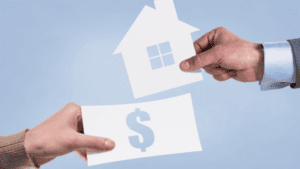Last updated: June 2025
Selling a home comes with a long to-do list. And if you’ve tapped into your home equity via a Home Equity Line of Credit (HELOC), you might wonder: What happens to your HELOC when you sell your home?
Whether you’re upgrading to a new property or cashing out during a hot market, it’s essential to understand how your HELOC fits into the sale. This guide breaks it down—clearly, simply, and with insight you can trust.
Access cash within days
Tap into your home’s potential in minutes. Start our streamlined digital application to discover if a HELOC is right for you.
What is a HELOC?
A HELOC is a revolving line of credit secured by the equity in your home. Much like a credit card, it gives you flexible access to funds, which you can borrow and repay repeatedly during a defined draw period, typically 5 to 10 years.
How does a HELOC work?
After the draw period completes, the repayment period begins, during which you can no longer draw funds and must pay off the balance over time.
Unlike a home equity loan (when a lump sum is provided instead), a HELOC offers ongoing access to funds up to a set limit, making it ideal for ongoing expenses like renovations or debt consolidation.
But it also means the lender places a lien on your property until the line is closed and paid off.
Can you sell a home with an active HELOC?
Yes, you can sell your home even if you have an open HELOC—but you’ll need to pay it off before the sale closes. Because your HELOC is a lien on your property, it must be satisfied (paid in full) so the buyer can receive a clear title.
The title company or escrow officer will request a payoff letter from your HELOC lender, which outlines the exact amount needed to release the lien.
That balance, plus any accrued interest or fees, will be deducted from your sale proceeds at closing.
What happens to your HELOC when you sell your home?
A step-by-step breakdown:
- Your home is listed and goes under contract.
- A title search is conducted, revealing the active HELOC.
- The payoff request is sent to your HELOC lender.
- The HELOC balance is paid directly from the sale proceeds at closing.
- The lien is released, and the new owner receives a clean title.
Hypothetical example:
Imagine you sell your home for $450,000 and owe $300,000 on your first mortgage and $25,000 on your HELOC.
The $325,000 in total debts would be paid out of the sale, and you’d receive the remaining $125,000 (minus fees and taxes).
HomeEQ’s digital platform makes this process simple by allowing you to track balances and request payoff letters entirely online, eliminating manual paperwork and delays.
What if your HELOC balance is higher than your home equity?
In rare cases, your home may not sell for enough to cover your outstanding loans. If your HELOC balance, combined with your first mortgage, exceeds your home’s sale price, there are three options:
- Bring cash to closing to cover the shortfall.
- Request a short sale, although this requires lender approval and may have credit consequences.
- Refinance before selling if your equity situation allows.
Important: If you’re underwater or near break-even, consult a financial advisor or real estate attorney before proceeding. HomeEQ provides general education, not personalized legal advice.
Should you close your HELOC before listing your home?
Closing your HELOC before you list can simplify the sales process.
Here are the pros and cons:
Pros
- Streamlined closing process
- Improves buyer perception (no second-lien red flags)
- You’re not tempted to draw more funds before selling
Cons
- Potential early closure fees (check your HELOC terms)
- Loss of liquidity for moving expenses or your next home
It comes down to your financial strategy and timing. Some sellers prefer to keep the line open until the day of closing for flexibility.
What if you’re selling one home and buying another?
If you’re moving from one home to another, timing your HELOC payoff can feel tricky. But with digital lenders like HomeEQ, the process is easier than ever.
Once your home sells and the HELOC is paid, you’re free to apply for a new HELOC on your next property.
In some cases, you may be able to roll the payoff amount into a new mortgage, depending on the equity and lending rules. Just make sure everything is disclosed and aligned with your sale timeline.
FAQs about selling a home with a HELOC
Do I have to notify my HELOC lender before listing?
No formal notification is required; however, contacting your lender early can expedite the payoff request process.
Can I keep the HELOC open after the sale?
No. Once the home is sold, the line must be closed and the lien removed. HELOCs are tied to a specific property.
How do I request a HELOC payoff letter?
Most lenders offer online portals or email instructions. With HomeEQ, you can request a payoff digitally in minutes.
Will closing the HELOC affect my credit?
It might slightly impact your credit utilization ratio, but paying it off in full is generally positive for your credit over time.
How long does it take to release the lien?
Typically, it takes 5–10 business days after the payoff is processed and verified by the lender.
What happens to my HELOC if I sell my home? The bottom line
Whether you’re planning to sell this year or just exploring your equity options, it’s smart to know where your HELOC fits in the process.
At HomeEQ, we empower homeowners with a digital-first experience—from application to payoff.
Check your rate in minutes, or explore how long it takes to get a HELOC to see if it fits your timeline before selling.




